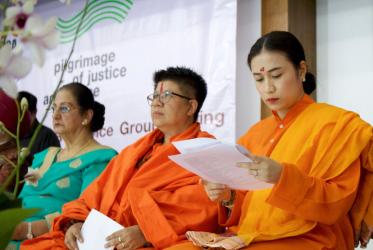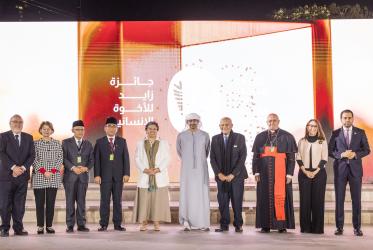The document provides five fundamental principles of “transformational formation”, and ten practical pointers for initiatives of common formation. The text was finalised in December 2022 by an interreligious team of educators with significant experience in formation processes of religiously diverse groups. It is a follow up to the conference on “The Future of Interfaith Dialogue,” organized by the WCC programme on interreligious dialogue and cooperation in December 2021 in which participants discussed principles for common formation as a vital element for the future of interfaith dialogue.
Rev. Dr Simone Sinn, academic dean at the Ecumenical Institute, moderated the launch. She thanked the working group that developed the text and underlined: “This booklet comes out of lived experience, and is aimed at inspiring further lived experience. This document gathers insights and best practices of common formation in different settings, and affirms initiatives of common formation geared toward interreligious solidarity.”
Rev. Dr Kuzipa Nalwamba, WCC programme director for Unity, Mission and Ecumenical Formation, pointed out that within the message of the WCC 11th Assembly, “there is a very strong affirmation of a common journey with people of goodwill, and particularly people of faith, so that we work together towards justice, reconciliation and unity”. She highlighted that interreligious solidarity is an important dimension in WCC’s strategic plan approved this year, with the WCC interreligious dialogue and cooperation programme coordinating this cross-cutting work.
Dr Clare Amos, theologian at the Church of England Diocese in Europe and coordinator of the working group for the booklet, reflected that the Ecumenical Institute at Bossey has always been a place where common formation has been seen as part of its core purpose. She introduced the new document by reflecting on interreligious learning processes.
“As is suggested in this booklet, there are sometimes two processes seen as being two distinct types of interreligious dialogue: face-to-face and side-by-side,” she said. “Side-by-side implies people of different faiths working together on projects intended to benefit the wider community.” She underlined that in common formation both dynamics come together. “In common formation people learn together and learn from each other with the goal of being equipped for leadership.”
Rabbi Margo Hughes-Robinson, participant in the Bossey Interreligious Studies course, recalled her own years in seminar and being introduced to interreligious dialogue. “It’s a very vulnerable thing, especially when you are in that very tender moment of formation,” she said. “I had a number of experiences in seminary. The ball started rolling and it was almost impossible to stop it, particularly because the fruits of it were so rich. I found a deep resonance with the document.”
Dr Zainal Abidin Bagir, director of the Indonesian Consortium of Religious Studies, underlined that the point which attracted him most in the document was “the reminder that the work of formation is actually also the work of transformation.” He further reflected on the importance of respect. “Sometimes respect means respecting boundaries, but in real interreligious dialogue and formation it also involves questioning boundaries. This is risky, yet rewarding.”
“Interreligious study is not simply an intellectual endeavor—it is something more,” he said.
Download and read "Building Interreligious Solidarity in Our Wounded World"





